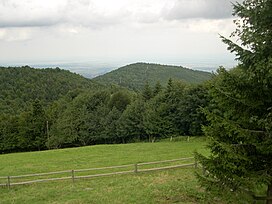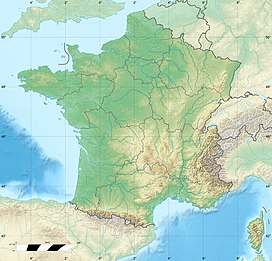Hartmannswillerkopf
| Hartmannswillerkopf | |
|---|---|
| France | |
 The memorial at Hartmannswillerkopf | |
| For World War I battles at Hartmannswillerkopf | |
| Location | 47°51′32″N 7°9′0″E / 47.85889°N 7.15000°E |
| Hartmannswillerkopf | |
|---|---|
| Vieil Armand | |
 The Hartmannswillerkopf from the Molkenrain | |
| Highest point | |
| Elevation | 956 m (3,136 ft)[1] |
| Coordinates | 47°51′40″N 7°09′40″E / 47.86111°N 7.16111°E |
| Naming | |
| English translation | Old Armand |
| Language of name | French |
| Geography | |
| Parent range | Vosges Mountains |
Hartmannswillerkopf, also known as the Vieil Armand or Hartmannsweiler Kopf (Hartmansweiler Head) is a pyramidal rocky spur in the Vosges mountains of Alsace. The peak stands at 956 metres (3,136 ft) overlooking the Rhine valley. At Hartmannswillerkopf stands a national monument of World War I for the fighting which took place in the trenches here.
Mountain peak
The peak is located 9 kilometres (5.6 mi) from Cernay and 24 kilometres (15 mi) north of Mulhouse. The mountain is shared by the towns of Hartmannswiller, Wuenheim, Wattwiller and Uffholtz.
Battle
The French and Germans fought for control of the mountain peak during the First World War. Fighting took place throughout 1915. 30,000 died near Hartmannswillerkopf during the First World War, with the majority of deaths suffered by the French.[2] After about 11 months of fierce combat, both sides began to focus most of their attention farther north on the Western Front. Only enough men to hold the lines were left at Hartmannswillerkopf. The lines remained relatively stable for the remainder of the war and generally only artillery exchanges took place.
National monument
Today, the area is a French national monument. There is a museum and a cemetery at the site, and it is also possible to explore the extensive trench system. Because the lines were static for such a long period, the trenches are very well preserved, especially on the German side of the front line. As of 2011[update], restoration work ahead of the centenary of the war means that access to the memorial is restricted.
There is a small memorial on the D431 north of Vieil Armand, commemorating Halifax bomber MZ807 of No. 433 Squadron RCAF, which crashed nearby in December 1944.
On 3 August 2014, French President Francois Hollande and German President Joachim Gauck together marked the centenary of Germany's declaration of war on France by laying the first stone of a memorial at Hartmannswillerkopf, for French and German soldiers killed in the war.[3]
Gallery
-
The national Monument
-
Hartmannswillerkopf cemetery
-
Hartmannswillerkopf cemetery
-
Monument to General Serret
References
- ^ IGN maps available on Géoportail
- ^ Le Hartmannswillerkopf (68)
- ^ "French, German Presidents Mark World War I Anniversary". France News.Net. Retrieved 3 August 2014.
{{cite news}}: Italic or bold markup not allowed in:|publisher=(help)





